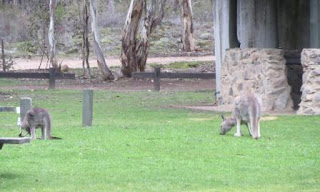8am
15 degrees and overcast. Steve headed off to find his fortune while I took
photos of our camp and the area.
There
is a day use area with information board.
The
kangaroos were doing the mowing.
On
one side of the board was some old newspaper articles – most interesting one
was in November 1856 – Bendigo Advertiser. “Gold still continues at 3pound
15shillings per ounce. We, yesterday, saw in the Adelaide Observer Office, a
splendid specimen brought in from Jones Creek (here). The weight was 52 ounces
and one or two pennyweights and after being crushed it yielded 34 ounces 12
pennyweights of pure gold.” That would be amazing to find.
The
gold diggings map.
On
the other side was information about the history and walks in the area.
Next
to it was an old mulberry tree planted in 1908 by Sam Ampfer.
I
got all my brochures out of the car and started to sort them.
Some
kangaroos popped in to say hello.
The
sky is heavier and misty rain came over a few times. Feeling quite chilly
outside though it says 16 degrees in the van. Steve didn’t have a good morning
– just shotgun pellets. I found 5 cents so I win!!
Had
some hot soup and open grills for lunch. Steve headed off again so I made some
pumpkin soup from Malcolm’s big pumpkin. Steve back for a cuppa and he found
colour – only a very little piece but it is gold so that’s a start. Texted Pete
& Penny – they will be here Monday week so hopefully we will have lots to
show them by then.
I
took a photo of it through the magnifying loop – looks much bigger!!
I
walked down to the cemetery. Along the way are other graves along the road.
Big
fancy entrance to Waanyarra Cemetery c1850 to 1990.
Big
shiny to photograph - “This first rush to this area occurred in 1853 and
brought with it deaths from mining accidents, illness and disease. The oldest
surviving marked grave in this historic cemetery is that of John Gibson Brown,
who died on October 10th, 1859. The recorded history of this rich
gold-mining region, indicates, however that many burials must have taken prior
to this date. Initially the cemetery was situated to the south of this site but
seasonal flooding of Jones Creek resulted in it being moved to this higher
ground. When Phillip Chauncey surveyed this area in 1861 a reserve for a
cemetery had been marked out on the north side of the Dunolly to Tarnagulla
road, west of this site but it was not favoured by local residents and was
never used. Chauncey officially named the area Waanyarra during his survey,
replacing the name ‘Beverly’ chosen by Governor LaTrobe. ‘Beverly’ was used
only by a few of the early goldseekers and was quickly forgotten. This eastern
section of the Waanyarra area, and the creek running through it, became known
as ‘Jones’ Creek’, after Charles Jones, an early prospector. Before the
introduction of wooden coffins it was usual to enclose a body between two
sheets of bark for burial. Local identity Mr Cheetham is credited with making
the first wooden coffin used here. It was made for the burial of a child. In
April 1871 a public meeting was held at Morton’s ‘Welcome Inn’ where the first
Trustees for the various sections of this cemetery were elected. They were:
Thomas Leach – Anglican; Thomas Boan – Hebrew; James Gourley – Presbyterian;
Michael Morton – Roman Catholic and William Holt – Wesleyans. These people
organised the burials and kept the cemetery in good condition for many years.
It was totally funded by public subscription, but as time passed and the
population of the area declined, money dried up and public interest in
maintaining the cemetery waned. This made the task of the Trustees very
difficult and they resigned their positions. A new team of Trustees
unsuccessfully attempted to rekindle community support and the cemetery closed
officially in 1891. Despite its official closure, local families continued to
use the cemetery for many years without permission, preferring to be buried in
family graves in the district in which they had lived for most of their lives.
As far as it can be ascertained, Mrs Deborah Chapple (nee Corrie) is the only
person to have gained official permission to be buried here since its official
closure. Debbie, as she was affectionately known, had been a tireless worker
for the maintenance of this cemetery. The Shire of Bet Bet became the Trustee
of the Waanyarra Cemetery in 1965 and
receives annual grants for its maintenance. Since 1988 an informal group, The
Families and Friends of Waanyarra, has dedicated itself to maintaining the
historic significance of the area. A bronze plaque recording the names of those buried here without a marker was placed
here by the group who have also cooperated with the Tarnagulla Recreation Parks
Committee, the Bet Bet Shire and its Development and Tourism Committee in the
erection of this signboard and the renewal of the front fence and gates.”
Lots
of small grave markers.
As
I walked back I found some pieces of old china in the road.
Nice
camp oven dinner by the fire. The clouds have all disappeared and the stars are
shining brightly. Spotted a few satellites and some planes pass overhead.
Checked the temperature at 7.30 and it was 8.3 degrees outside and only 13.4
inside so put the heater on.


































No comments:
Post a Comment